Category — activism
In praise of The Bubble
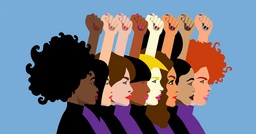
“You’re just in your own little bubble.”
This is offered as an insult. A bubble is bad thing. Being in a bubble implies (well, more than implies) that you purposely and exclusively surround yourself with people who think, talk, live and look like you, your political, cultural, religious, economic, racial, gender-identified bedfellows.
The bubble is, by this definition, an unchallenging, unmotivating place, a somnambulant comfort zone that you share with fellow bubble-dwellers. Or maybe it’s just your own private world, isolated and insulated from what is happening all around you. A bubble by this definition is solipsistic, self-involved. Those who reside inside it are resistant to acknowledging, reaching out, getting to know and working to understand the “other.”
Maybe.
I mean, yes, a bubble can be all that. But I’d like to argue for another kind of bubble. Especially during the past four dark, nasty, soul-crushing years, I have sought out and immersed myself in a bubble. My bubble is not geographic—although living on the “upper Left coast” sure helps. It is not age-specific. The bubble includes people from 26-81 years old. It is not race-specific. The bubble includes people of many hues. Some in this bubble I have known for most of my life. Others are newcomers. Some, most, I know IRL. Others I have connected and bonded with over social media.
What we have in common, what has sustained me these past four years, is our commitment to social justice and meaningful change, our love of our communities and our work to keep those communities vibrant, our persistent and stubborn belief (sometimes to the contrary of all we see) that people are good and want to do good and do indeed care about each other. What we have in common is our resilience. When during these past few years more shit hit the fan than anyone knew there was shit out there, we were appalled, we were furious, we yelled, we cried. And then we took a breath, gave ourselves a talking to, reached out and jumped back into it. That meant everything from taking to the streets to cooking food for the hungry, from running for political office to helping find jobs for the previously incarcerated, from making music to sewing masks. And more. So much more.
I owe my sanity to this bubble. I thank you all. You know who you are.
In memory of, in praise of RBG. Of course.
November 18, 2020 2 Comments
Ode to November 3

I believe:
We are at the beginning of the end of these dark, dark days.
We value honesty, integrity, inclusivity.
We believe in facts.
We know when we are being conned.
We own our mistakes and want to do better.
We care about each other.
We can transform anger into action.
We are learning to speak truth to power.
We know there is much to be done.
We are willing—we are so ready–to do it.

October 29, 2020 3 Comments
Performative Compliance…whaaat?

I’m going to coin a new phrase here. At least I have not come across it elsewhere: Performative Compliance.
This refers to the actions of states, cities, businesses, schools in the face of the persistent threat of COVID-19. I’ve been thinking about this since I temporarily left my Eugene Bubble and ventured out into one of those states that is not, to put it mildly, part of the “blue sweep” many of us are hoping (and working) for 13 days from now.
I think there may be 3 levels of compliance to those protocols SHOWN and PROVEN to mitigate the spread of the virus.
First is true adherence. Every public indoor place has a “no admittance without a mask” sign prominently displayed. And THERE IS NO ADMITTANCE WITHOUT A MASK. As in, enforced. Public indoor places have FLOOR MARKINGS to help people stay at least 6 feet apart from each other. Other spaces are reconfigured to make this possible. GLOVES and hand sanitizer are everywhere. In restaurants (with indoor or outdoor seating), there are no ketchup bottles, salt and pepper shakers on the table, nothing that would be touched by many people. And much more.
The second is what I have discovered in my out-of-the-bubble experience: Performative Adherence. I’ll just give this one example. On one end of a table is an ice/ water dispensing machine operated by 2 touch buttons. Two feet away, on the other end of this table, taped to the table itself (so not at eye level) is a sign that says you should wipe down high-touch surfaces. The wipes are not there. The wipes are in an unmarked plastic container on a shelf located elsewhere. Did anyone who used the ice machine see the sign, find the wipes and obey? I stood to the side and watched 4 people. No one saw the sign. Each person touched the button the previous person had touched.
Did the facility comply to the “wipe surfaces” mandate? You be the judge.
The third level, which I have not experienced but, like all of you, have read about in social media, or seen in videos featuring parades of the maskless marching through big box stores, is no compliance at all. These are folks who call COVID the “Wu-Han virus” and believe the ongoing pandemic is mostly a figment of the Left’s imagination. Their interpretation of our President’s recent bout of illness is: See, it’s not that dangerous. Or: What a dude! How strong! How invincible!
It’s Level 2 that I find so disturbing. Entities pretending to obey mandates and policies but making it easy for no one to obey. Doing what you have to do to avoid litigation but not what you are supposed to do to avoid creating an unhealthy environment. It’s the sneakiness of it, the backhandedness of it. At least the maskless mobs are “true” to their beliefs.
October 21, 2020 6 Comments
To fight we must be strong

I used to think “self-care” was the special bullshit of the Me Decade (and beyond) privileged who wanted to feel less guilty about their spa days. “I need a little Me Time” was code for “I am a self-involved, selfish jerk. Why don’t you just shoulder my burden as well as your own while I go center myself.”
This was back when I was so protected from (and ignorant of) the kind of life that would have called for radical self-care that I could espouse such an attitude.
Now I know better. I know better because I am no longer protected. None of us are. And some of us never were, I realize that. I understand the privilege of that.
And here’s what I also understand:
I understand that to keep fighting we need energy, and to have energy we have to gather it within ourselves, to feed ourselves. I understand that to keep fighting we have to hold onto both our sanity and our optimism, which are eroded every day by the ongoing catastrophes of this place we call our country. And to hold on, we have to dig deep, and we can’t expect others to do that work for us. I understand that to keep fighting we have to keep resilient, to not just “bounce back” but to “bounce forward,” as a psychologist friend recently put it.
So: Self-care.
What to do? A foot massage would be lovely, but not now, so not-now. A long, leisurely coffee date with a good friend would be delightful. But there is no one outside my family who is in my bubble, and I don’t go outside my bubble. Speaking of which…a bubble bath. Sure right after I deep-scrub that tub, which is not, in my book, a good precursor to a self-care experience.
So I go outside. I don’t mean I bike, hike and run. I do all these things, and I believe they help keep me healthy (and dopamine-infused). I mean I sit on the porch and listen to the jays. I crouch in the garden and watch the quail. I kneel beside spider webs and take pictures of them. I try to take cues from my cat.
And, in the spirit of all that, I offer these images. May they help support whatever your version of self-care is.



October 8, 2020 3 Comments
The people I love the best

This. This. This.
This poem by Marge Piercy.
This poem about the hard sweaty work that needs to be done–and those who harness themselves, like an ox to a heavy cart, and do it.
The people I love the best
jump into work head first
without dallying in the shallows
and swim off with sure strokes almost out of sight.
They seem to become natives of that element,
the black sleek heads of seals
bouncing like half-submerged balls.
I love people who harness themselves, an ox to a heavy cart,
who pull like water buffalo, with massive patience,
who strain in the mud and the muck to move things forward,
who do what has to be done, again and again.
I want to be with people who submerge
in the task, who go into the fields to harvest
and work in a row and pass the bags along,
who are not parlor generals and field deserters
but move in a common rhythm
when the food must come in or the fire be put out.
The work of the world is common as mud.
Botched, it smears the hands, crumbles to dust.
But the thing worth doing well done
has a shape that satisfies, clean and evident.
Greek amphoras for wine or oil,
Hopi vases that held corn, are put in museums
but you know they were made to be used.
The pitcher cries for water to carry
and a person for work that is real.
“Marge Piercy is not just an author, she’s a cultural touchstone. Few writers in modern memory have sustained her passion, and skill…” — THE BOSTON GLOBE
Image: Vincent Van Gogh, Red Vineyard at Arles (1888)
September 2, 2020 2 Comments
The exception(s) that DISPROVE the rule

When are there so many “exceptions that prove the rule” that the rule itself is negated? How many “exceptions” does it take for the rule to become obsolete, for us to forever forget the damned rule?
I am thinking of Ruth Bader Ginsberg here. I am thinking of Georgia O’Keefe. Toni Morrison. Beverly Cleary. Sadie Delany. Oh, for goodness sake, Betty White. I am thinking of all these “exceptions that prove the rule,” these old women who are/were strong, vital, spirited, energetic, resilient, creative, interesting. The “rule” they are/were all exceptions to? It’s the rule that states to be old means to be sickly, fragile, dependent, boring–and useless. And in the way.
Yeah, yeah, Bernie mounted the most energetic campaign possibly in the history of campaigning at age 74. And Grandma Moses didn’t start painting seriously until she was 78. And sure, Ruth is rocking it on the bench at 87. But whenever we hear about active, engaged, powerful people who are 75 or 80 or, gasp, even older, they are presented as exceptions. Because everyone knows that old people are creaky, crabby creatures who totter around (if they’re lucky), eat bland mushy food, natter on about their ailments, and hold up the line at the grocery store by writing checks. Checks.
Among the countless things that anger (stun, depress, disgust, worry) me these days is institutionalized ageism. Yes, I said ageism. Not racism, sexism, homophobia. Well, of course racism, sexism, homophobia. But those -isms and –phobias are at least part of our national conversation. We protest in the streets about them. We attempt (sometimes successfully) to create policies that weaken their hold. They are discussed in schools, in the media, on the lecture circuit. I am not saying we have come close to conquering these forms of discrimination. I am saying we are talking about them.
And then there’s ageism.
It is not just firmly embedded in popular culture. It is mostly invisible–thanks to the imposed and self-imposed ghettoization of the elderly (from nursing homes to upscale retirement “communities”).
The old stereotype is accepted virtually without question. Haha. Read the funny birthday cards about clueless, forgetful old people. The memes. The street signs that show us what we think: A silhouette of a stooped (oh that dowager’s hump) old lady grasping a cane. She can hardly place one foot ahead of another. Watch her struggle as she totters, oh-so-slowly, across the street.
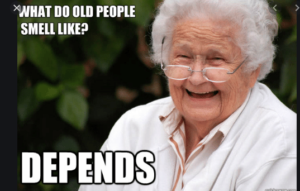
And then there’s Ruth. And Toni. And Betty. You know, the “exceptions.”
As George Bernard Shaw famously wrote: We do not stop playing because we grow old; we grow old because we stop playing. (He lived to age 94.)
Ruth is in the game. She is a player. She is, in fact, the hands-down winner of the MVP award.
She is brave and honorable. She is persistent and tireless. Let’s honor her by NOT calling her “the exception that proves the rule.” Let’s trash the rule.
Here’s what I wrote a while ago about old people in Europe, where old people are part of the life of their communities.
August 19, 2020 2 Comments
Joe’s cabinet, sez me

We waited long months for Joe Biden’s VP pick. He had such a talented pool from which to choose.
When he takes office Jan. 20, 2021, he will start selecting his cabinet. And again, he will have an extraordinarily talented pool. Remember when the current resident of the White house proclaimed he had chosen “the best cabinet ever assembled” with “the highest IQ?” (Really? They took IQ tests? Did any involve identifying an elephant?) That patently absurd boast joined so many others. Remember these:
I am the least racist person you will ever meet.
Nobody has more respect for women than I do.
I am more presidential than anyone other than the great Abe Lincoln.
No one has done more for people with disabilities than me.
No one has done so much for equality as I have
On the off-chance that Joe Biden consults with me on his cabinet picks, I will give him this list:
Agriculture, Amy Klobuchar
Commerce, Frank Pallone
Defense, Susan Rice
Education, Michelle Obama
Energy, Jay Inslee
Health and Human Services, Jeff Merkely
Homeland Security, Val Demings
Housing and Urban Development: Julian Castro
Interior, Jennifer Morris
Labor, Bernie Sanders
State: Elizabeth Warren
Transportation, Darnell Chadwick Grisby
Treasury: Andrew Yang
Veterans Affairs, Tammy Duckworth
How about you? Please comment, add, amend. And, if a name is unfamiliar, check it out. So much talent. So much expertise.
August 12, 2020 10 Comments
To ACT is to FOCUS

You know—don’t you?—that multi-taking doesn’t work.
The brain is not capable of simultaneously performing two or more tasks that require our focus and attention. Instead, a kind of toggle mechanism allows the brain to switch from one task to another. The switch is rapid, so you think you’re doing two things at once and oh-so productive, but you aren’t and you’re not. In fact, toggling leads to errors, and the tasks take more time than if you were to focus on each individually. Toggling also, over time, leads to a special kind of exhaustion. As all of us supposed multi-taskers know.
Why am I writing about this now?
Because all of us who care deeply about and want to be meaningfully involved in the crucial issues of the day have been forced into exhausting, debilitating—and inefficient—multi-taking. We are so overwhelmed with what is wrong, with what needs our attention, with what we need to learn more about, with how to be part of the struggle(s) and the change(s), that our brains are toggling toggling toggling.
Our focus shifts from moment to moment: another outrageous statement by the man in the White House, another heart-stopping virus statistic, another video of federal troops in city streets, Russian hackers, white supremacists. And then there are those concerns we had, those fights we were fighting, before all this. Remember climate change? Criminal justice reform? Homelessness? Food insecurity?
Like you, I am overwhelmed.
I cannot do everything.
I cannot do nothing.
I must do something.
And to DO something, I must focus. I must put a stop to all this exhausting and inefficient toggling. I invite you, even just for the next 24 hours, to do the same.
What is helping me focus today on an issue I care deeply about (one that intersects with race, COVID and MOTUS—that’s the acronym for Monster of The United States) is this new album by my fellow Food for Lane County Dining Room volunteer, Steve Gibson. He wrote the songs beginning in 2011 when he started volunteering. They tell of the people he met and his own efforts to stay in the fight, to do the work. (It’s the final song on the album, Compass.)
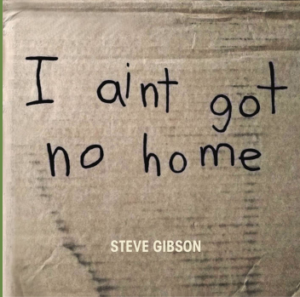
Here’s the link to the album. All proceeds go to Food for Lane County.
And here’s the link to Steve’s live performance tomorrow (Thursday, 7 pm Pacific).
Listen. Contribute if you can.
We can’t do everything. But we can FEED ONE PERSON who would normally go hungry. That is what we can do today.
July 22, 2020 No Comments
On the plantation
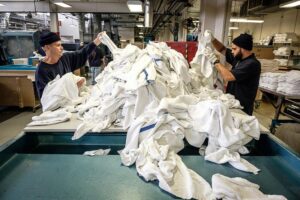
The noise is deafening. In the cavernous “wet room” it is the churning of industrial washing machines. In the warehouse-sized “dry room” it is the whirr and whine of the dryers. With the fans blasting, the air is nonetheless hot, close, muggy. Like Georgia in late June. Like a plantation in Georgia in late June. The similarity only begins there.
I am describing Oregon’s second largest commercial laundry, a facility I toured a few years ago when researching and writing A Grip of Time. It is housed behind the 25-foot concrete wall that rings Oregon State Penitentiary and is one of more than two dozen businesses operated by a private entity within the Department of Corrections that manages labor contracts for the state’s prisons. Like those who labored in plantations in the South, the men who work in the laundry are slaves. Or at least indentured servants. Like plantation slaves, they are provided with (as one historian of the mid-1800s described it) “crude lodging, basic foods and cotton clothing.” The slaves of the South and the slaves within prison walls live in marginal conditions isolated with “their own kind,” working to support an economy they are not a part of.
Plantation slaves received no wages but could sometimes sell their services, after work, for nominal earnings that might equal as much as $100 a year. Prison laborers in Oregon are paid between 5 and 47 cents an hour. I’ll do the math for you:
$100 in 1860 has the purchasing power of $3,100 today.
The prison job, assuming 40 hours a week, 50 weeks a year at the top wage of 47 cents equals $977 a year.
The laundry work is low-level, menial labor that does not foster job skills useful to prisoners after release. The working conditions are unhealthy: loud enough so that earplugs are almost useless, the air in the “dry room” linty enough so that masks are required, the temperature hot enough so that everyone sweats all year.
Given all this, I should be overjoyed with the news that Oregon Health Sciences University, one of the laundry’s biggest clients, just announced that it is terminating its contract (in place since 1995).
Willamette Week reported it this way: Now, following a nationwide reckoning against racial injustice and demands for criminal justice reform, OHSU says the use of prison labor runs counter to its values. “The foundation on which our prison systems lie, and on which programs like laundry services operate, is antithetical to our values,” the president of OHSU said in a statement.
And, um, this conflict-of-values was just discovered after 25 years of supporting the laundry?
Still, I should be overjoyed, but here’s why I’m not.
Jobs in the laundry are actually considered the top jobs in the prison. They pay the most, offer two or sometimes three working shifts, are the only jobs to offer overtime, and are the only jobs to keep operating during lockdowns.
The men employed in these jobs, many of them, are trying to save money to show Parole Boards (and their families) that they are responsible. Or they are using these funds to pay for “luxury” canteen items like stamped envelopes so they can write to their families. Or an extra roll of toilet paper.
I am glad OHSU has decided prison labor runs counter to its values. Now how about we use this moment to examine the entire morally bankrupt system of mass caging of human beings that runs counter to OUR values?
July 1, 2020 2 Comments
The crisis is now
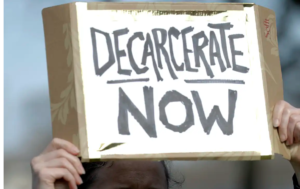
Isn’t it “under control?” Are we all just thrilled that our states and counties and cities are “opening up?” Are we looking forward to those summer parties? Making those summer travel plans? Because, you know: Flattening. The worse is behind us. Or, as the informed and deeply thoughtful members of the First Family tell us, the virus is about to “magically” disappear.
Regardless of what is happening in your community, in your state—and I hope the news is as good as it can be—please know this: Cases of the coronavirus in prisons and jails across the United States have soared in recent weeks. The number of prison inmates known to be infected has doubled during the past month. The Marshall Project reports that 46,967 prisoners have so far tested positive. Prison deaths tied to the coronavirus are up by 73 percent since mid-May.
Now, according to the national database maintained by the New York Times, the five largest known clusters of the virus in the United States are not at nursing homes or meatpacking plants, but inside correction institutions.
Of course they are.
We have heard for months that prisons and jails would be hot spots, that they are extreme high-risk environments.
They are often overcrowded, unsanitary places where social distancing is impractical, bathrooms and day rooms are shared by hundreds of inmates, and access to cleaning supplies is tightly controlled. Add to this that we have an aging (and chronically ill) prison population with limited access to health care. Oregon, my state, has one of the oldest incarcerated populations in the nation. Once behind bars, prisoners age faster than the rest of us. Health researchers estimate from 10 to 15 years faster.
The response from governors, from Departments of Corrections and from officials within prisons themselves has been inconsistent, muddled, mostly ineffective. A few states have moved forward with robust testing. Most states have not. Some states are releasing medically vulnerable prisoners; others are not. Many are stalling, arguing politics. This is not about politics. This is about health. Men and women are dying.
The crisis is now. The response must be now: testing for all; release not just for the medically vulnerable and aged but for all low-risk inmates who have served at least half of their sentences.
June 17, 2020 1 Comment





